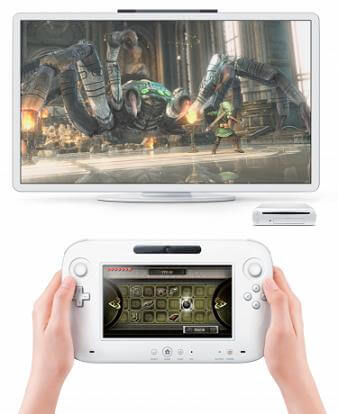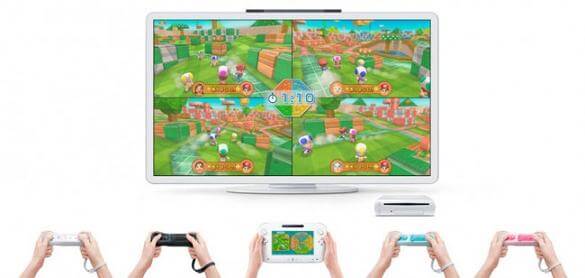 Nintendo’s Wii U is designed around an ill-convinced, regressive, illogical idea of a large, expensive, complicated, touchscreen controller. I’m sure it’ll be a good game system overall, but the large touchscreen controller is so unnecessary.
Nintendo’s Wii U is designed around an ill-convinced, regressive, illogical idea of a large, expensive, complicated, touchscreen controller. I’m sure it’ll be a good game system overall, but the large touchscreen controller is so unnecessary.
Nintendo came up with the concept, I think, because they didn’t know where else to go. Now that the XBox and Playstation have their own gesture-based interfaces, gesture-based gaming is not a USP for Nintendo anymore. If Microsoft had not come up with Kinect, Nintendo would have invented something like it, because it would have be a natural progression from Wiimotes. And of course, creating a more precise Wiimote is what Sony just did with PS3 Move.
So what direction should Nintendo have gone? I think they should have focused on portable gaming and game development, forgetting about releasing a new living room system. They should have just became a third-party developers for Sony and Microsoft’s systems.
Keep in mind that the Wii was released 1.5 years after the XBox 360, and is being replaced before the 360 is being replaced. That’s not how it’s supposed to happen, and to me it’s a hint that Nintendo cannot complete in the hardware business, with portable gaming (which I just don’t care about), being the exception.
But instead, they’re going ahead with a new console. And because their USP was co-opted, they had to come up with another one, which, as I mentioned, is the large touchscreen controller.
Aside from the regressive nature of the idea, it a bad idea in terms of user experience. For one thing, most people are going to only have one of the big controllers, due to their expense. So, Nintendo imagines that there will be one person with the big controller and other people with regular Wiimotes.

It seems to me that that is really going to draw attention to the backwards evolution of Nintendo’s controllers. One guy will be using this behemoth controller with tons of buttons and it’s own display, with the guy next to him using a minimalistic, gesture-based controller with 3 buttons, playing the same game. At least it’s a tacit admission that the the big controller is superfluous.
But more importantly, the idea of a secondary display that the user has to regularly reference is just absurd. Has Nintendo ever heard of HUDs, or Heads-Up Displays? In cars and planes, they’re an improvement over dashboard-embedded gauges, for obvious reasons. If you’re doing something that requires close attention and quick reflexes like driving, flying a plane, or, I don’t know, playing video games, it’s better to not have to look away from the thing you should be focusing on.
Nintendo has tried to show instances where a secondary display would be cool and / or practical, and I’d like to address a few of them:
1. The secondary display can displays maps. How practical is this? In most games where you would want a map, there’s an in-game map. Games that require frequent use of a map typically have a mini-map. But the mini-map clutters up the screen! Okay, then have the mini-map only come up when the user holds down a button. Is that significantly slower or less convenient than looking away from the screen at the secondary display? Nope.

2. Use the secondary display to catch a ball or aim a pitch in a baseball game. This one is pretty funny. Look at the screen above. Why would you want to focus on the screen you’re holding rather than on the main display? You obviously would not be able to focus on both at the same time. Okay, if you aim a pitch via the smaller display, you can aim it so that the other player in the room can’t see where it’s going to go. Okay, Nintendo, you win. That totally justifies having an expensive monstrosity of a controller.
3. Put the secondary display on the floor and use it as a virtual golf tee. A regular Wiimote can be used as the golf club. I guess this kind of makes sense, because in real golf you’re not supposed to take your eye off the ball when swinging. So, this would be better for golf simulations. But simulation games are a niche market, and the people who buy them aren’t Nintendo’s target audience. In addition, this seems pretty awkward. How good of an idea is it to put an expensive controller on the floor where it can easily be stepped on? And using a second controller to swing? Compare this to Kinect, which can track the user’s whole body and render the movements on screen, without any tactile controller. Doesn’t that seem to be a more Nintendo-like approach? Doesn’t that seem much more elegant, impressive, and kid-friendly?
Controllers should generally become invisible as the user familiarizes himself with the controls of a game. What each button does should become second nature. The user should eventually not have to look down at the controller at all when playing a game. The Wii U goes against that completely. It’s draws attention to itself, and will work against players becoming engrossed in a game.


